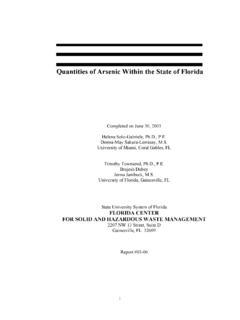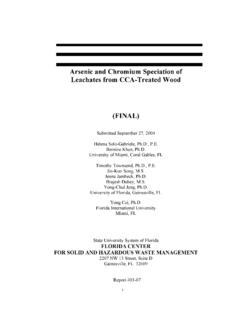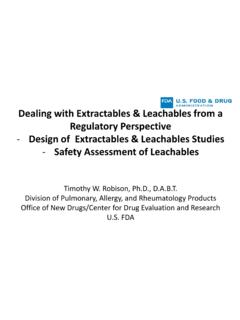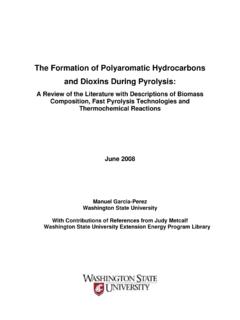Transcription of Effect of Coatings on CCA Leaching From Wood in a Soil ...
1 Effect of Coatings on CCA Leaching From Wood in a Soil Environment David E. Stilwell and Craig L. Musante The Connecticut Agricultural Experiment Station PO Box 1106, New Haven CT, 06504. e-mail Phone # - 203-974-8457. Fax # - 203-974-8502. ABSTRACT. We are conducting a study to determine the extent that coating CCA wood with a variety of paints and stains has on preventing Leaching of the preservative into soil. A total of 10 boxes (27x28x14 cm) were constructed, six of which were coated. The Coatings consisted of oil based, semi-transparent stains (two brands, one with and the other without alkyd resin ingredients), two clear cover Coatings (two brands, one with a penetrating alkyd/acrylic formulation), an opaque acrylic deck stain, and an opaque polyurethane enamel.
2 Two of the boxes made from CCA wood were left uncoated, as were the control box and the box made using the ACQ preserved wood. The boxes were filled with a mixture of 90% soil (sandy loam) and 10% compost, by volume, and placed out to weather on April 30, 2002. The soil was sampled using a core sampler from each side of the box, 0-3 cm from the wood, 107and 365 days after weathering. Elevated arsenic and copper levels were detected in soils from the uncoated boxes and in some cases from the coated boxes. Concentrations (mg/kg) of As in soils receiving different treatments were; No coating ( ) > Oil based stain with alkyd resin ( ) > Oil based clear cover sealant ( ) > Oil based without alkyd resin ( ) > Water based clear with alkyd and acrylics ( ) > Acrylic opaque ( ) > Polyurethane ( )> Control ( ).
3 Key Words CCA Wood, Arsenic, Leaching , coating , Soil INTRODUCTION. The potential environmental problems associated with chromated copper arsenate (CCA) wood preservative resulted in a phase out of its use in the US for residential applications effective January 2004 (1). However, wood produced prior to the phase out is expected to remain in-service for many years (2). Moreover, this formulation is still permitted for use outside the residential setting. Arsenic dispersal from the wood can occur by Leaching , erosion, weathering, decay and physical dislodgement (3-10). coating the wood could minimize this arsenic dispersal by forming a barrier between the wood and the environment. Limited amounts of information have been published on Coatings for CCA wood.
4 Some studies have focused only on the on durability of the finish to withstand weathering (11,12), while others have focused on the ability of the finish to reduce surface dislodgeable arsenic (13,14) or leachable arsenic (15-17). In general, opaque polyurethane and acrylic finishes form the most durable Coatings (11,13,14), presumably due to their ability to protect the wood surface from ultraviolet radiation and David E. Stilwell and Craig L. Musante, The Connecticut Agricultural Experiment Station PO Box 1106, New Haven CT, USA, 06504, (203-974-8457) water penetration (11,16). Nonetheless, for some surfaces, particularly horizontal ones subjected to foot traffic, use of a penetrating stain that results in a slow wearing of the coating may be preferable.
5 Opaque Coatings applied to horizontal surfaces are prone to peeling and cracking with age. Other types of Coatings could form a barrier to arsenic but not maintain its integrity over time. For example, we found that even though spar varnish formed a barrier to arsenic dislodged from the surface (>90%. over 1 year), it later underwent severe deterioration after 2 years of weathering (14). Studies have been published comparing the durability of commercially available Coatings in residential settings (18). However, these studies did not address the coating 's potential to form a barrier to arsenic migration from the wood. In this study we are evaluating the effectiveness of Coatings to form a barrier to preservative dispersal from CCA wood in a soil environment.
6 Soil contact uses include raised beds used in gardens, posts, and utility poles. The results over the first year of weathering are presented in this report. EXPERIMENTAL. A total of 10 boxes (27x28x14 cm) were constructed, 8 using 3x15 cm CCA boards, one using an alternative preservative containing copper and quaternary ammonia (ACQ), and 1 control using untreated pine. The CCA containing boxes were constructed using m x 3 cm x 15 cm pine boards, purchased at a lumber yard, nominally treated with kg/m3 of CCA preservative by Universal Forest Products. The boards originated from three sets. The first set, consisting of 3. boards purchased in April 2002, was used to construct the two, 28 cm sides. Set 2, also purchased in April 2002, consisted of 1 board treated with water repellent plus CCA (Thompsonized), and was used to construct one 27 cm side of each box, while Set 3, consisting of 3 boards purchased in 1998, was used to construct the other 27 cm side of each of the 8 boxes.
7 Each paint or stain was applied in two coats on a particular box. As shown in Table 1, the Coatings consisted of oil based, semi-transparent stains (two brands, one with and the other without alkyd resin ingredients), water based Coatings (two brands, one with a penetrating alkyd/acrylic formulation), an acrylic solid color deck stain, and a polyurethane enamel. Two of the boxes made from CCA wood were left uncoated, as were the control box and the box made using the ACQ. preserved wood. The boxes were filled with a mixture of 90% soil (sandy loam) and 10% compost, by volume. The soil properties of this mixture are given in Table 2. The boxes were placed out to weather on April 30, 2002 (Figure 1). Natural rainfall supplied most of the water, but in times of drought, the soil in the boxes was watered at a rate of about one inch per week ( inches per application).
8 The soil was sampled using a soil corer ( cm dia.) to take one sample from each of the four sides of the box, 0-3 cm from the wood to box bottom, 4 times over 2 years. The results of first two sets of soil samples, taken after 107 and 365 days of weathering are given here. The results for the and 2 year sample sets will be given elsewhere. The Cu, Cr, and As were determined in the soil samples by nitric acid digestion followed by analysis using Thermo Jarrell Ash ICP-AES Atom Scan 16 atomic spectrometer. In samples containing low arsenic (< mg/l in solution) the more sensitive technique of graphite furnace atomic absorption (GFAA) was employed using a Perkin Elmer 5100 instrument, as described previously (9). The Cu, Cr, and As in the wood were similarly obtained by analyzing wood composite sawdust samples from each set of boards.
9 Table 1 Description of Coatings coating /Box # coating * Base Color Cover 1 None 2 Sealant with Alkyd and Acrylics Water Clear Clear 3 Deck and Siding Stain Oil Gray Semi 4 Sealant Oil Clear Clear 5 Deck Stain with Alkyd Resin Oil Gray Semi 6 Solid Color Acrylic Deck Stain Water White Opaque 7 Polyurethane Floor and Deck Enamel Oil Gray Opaque 8 None ACQ None Untreated None Pine * Brand and coating 2, Behr, 300; 3, Behr 1-765; 4, Thompson's; 5 Olympic, 53178; 6, Olympic, 53097; 7, Sapolin, 40-9309. Figure 1 Coated and uncoated box assemblies. Table 2 Soil Properties Property Measurement pH (n=9). CEC* (cmol/kg) (n=6). P (mg/kg) 1040 80 (n=3). Fe (mg/kg) 9090 1500 (n=3). Sand (g/kg) 712 17 (n=2). Silt (g/kg) 114 55 (n=2).
10 Clay (g/kg) 174 71 (n=2). Organic Matter (g/kg) 52 4 (n=2). *Cation Exchange Capacity RESULTS. Arsenic Leached The average soil arsenic levels right next to the wood in the boxes over time for different treatments are given in Figures 2-4 (see table 1 for the Coatings corresponding to numbers 2-7). The results from the soil samples from the uncoated CCA boxes (Box 1 and 8) were combined (n=8) in computing the averages for each weathering. All other averages were from each side from a particular box (n=4). The percent reduction was calculated by subtracting the amount of arsenic in soil from the control box from that in soil from each coated box, and dividing this by the difference between the arsenic in soils from uncoated boxes and the control boxes, 100*(Coat Value-Control Value)/(No Coat Value-Control Value).








